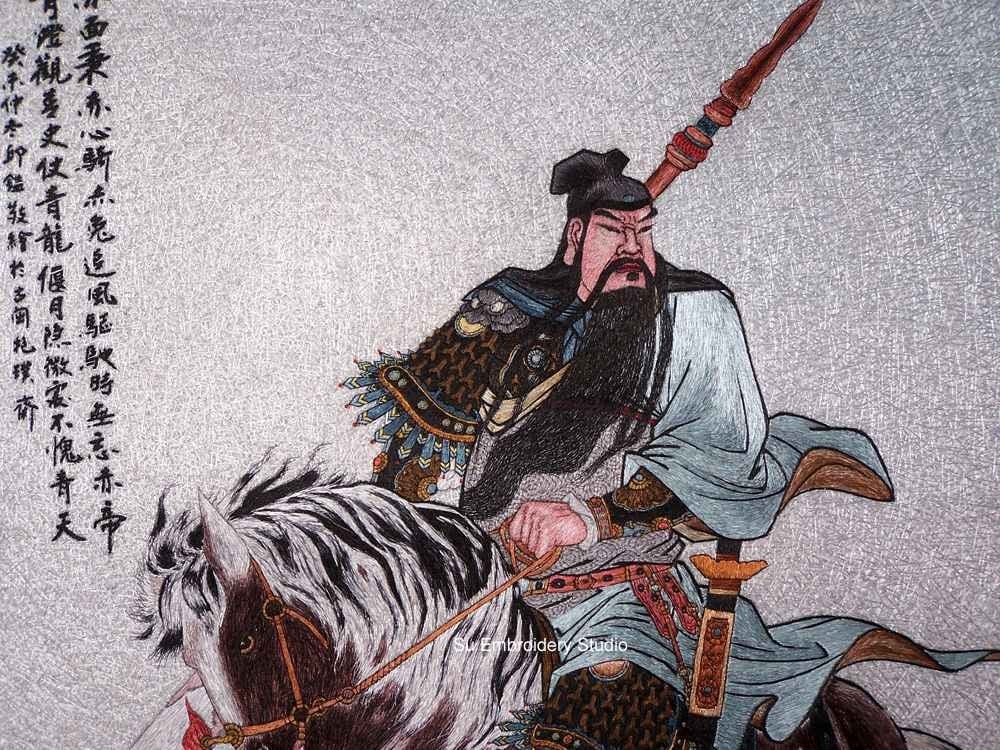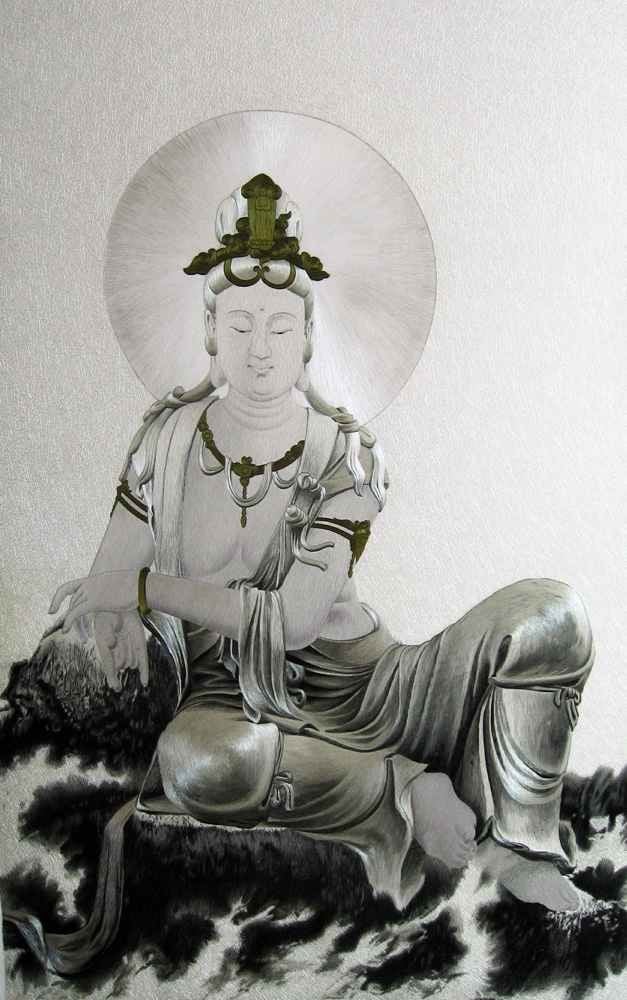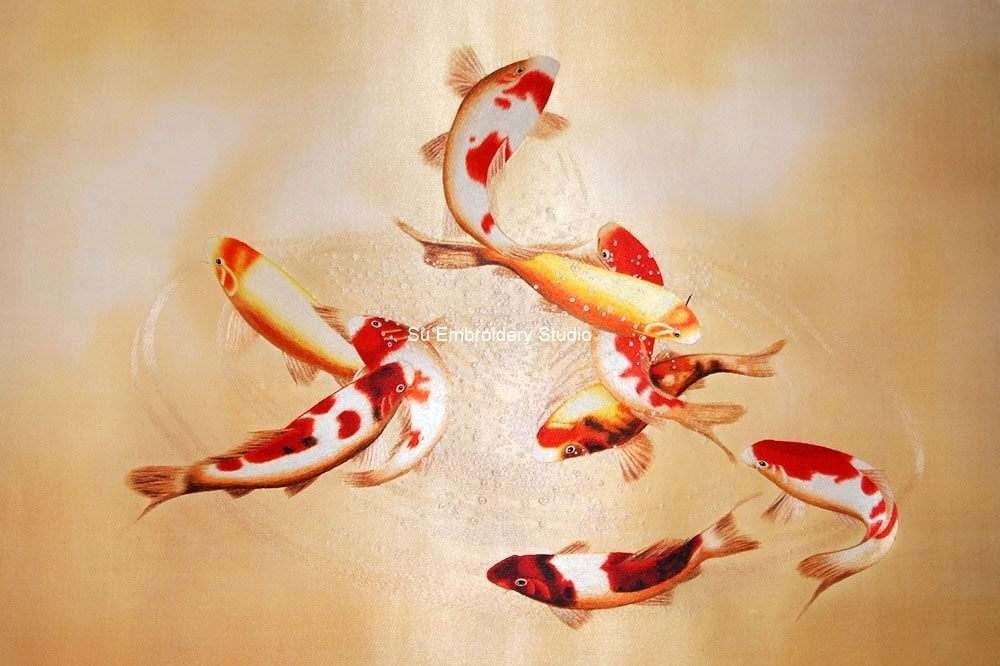
by Xu Tingchang
While all Chinese embroidery is exquisite, Suzhou embroidery is particularly striking. There have been many achievements in Suzhou embroidery, and it boasts a galaxy of artists with superb skills. In the early years of the 20th century, a pretty woman in East China won national fame for her exquisite silk embroidery and was then renowned in the world. She was Shen Shou, a Suzhou embroidery master and the most famoust Chinese silk embroidery artist who was described by noted Qing Dynasty scholar Yu Yue as a ‘needle sage’.
Her name at birth was Xuezhi, and she styled herself tianxiangge zhuren, which means ‘owner of the Heavenly Frangrance Pavilion’. She was born in the family of an antique trader at Haihongfang of Changmen, Wu county Jiangsu, on the 11th day of the eighth month of the 13th year of the Tongzhi Reign of the Qing Dynasty (Sept. 21, 1874). Her father, Shen Chun, studied literature and history, and was skilled at the salt business. He was once a government official in charge of salt business in Zhejing. He was an ardent collector of antiques, and opened an antique shop later in his life.
Xue zhi’s mother had three sons and two daughters – Xuezhi was the fifth. She was pretty, bright and clever, and was loved deeply by her father who expected her to be a young lady of note. As a child, she leaned Chinese characters and read books with her father, and studies Confucian classics. Her good family background and the family’s collection of antiques, calligraphy and paintings helped to develop her understand of the arts.
The city of Suzhou is known as the “home of Suzhou Embroidery.” In Mudu and other villages surrounding the city, almost every family breeds silkworms and there is an embroidery frame in every house. As a girl, Xuezhi often visited her grandmother, there her interest in the fascinating art of embroidery was cultivated.
She began to experiment with needlework at the age of seven and a year later, with the help of her sister Shen Li, was learning embroidery, getting and early start of what would be her lifelong passion. She had a natural understanding of stitching, and moreover, was utterly devoted to it. As a result, her talent developed rapidly. As first, she embroidered small pieces for use at home, mainly of flowers and plants. Later, she began to use the family’s painting collection as inspiration for her embroidery masterpieces.
Initially, her father objected to her learning embroidery, thinking that it was a useless skill. When he realized how deeply his daughter loved her art, he relented and allowed her to continue. By the time she was about 16, she was known throughout Suzhou for her stitching expertise.
At 20, she married Yu Jue, six years her senior. He was born in Shaoxing, Zhejiang, and later his family moved to Suzhou. He came from a well-off family of scholars, and was good at calligraphy and painting. After their marriage, Yu Jue devoted his time to calligraphy and painting while supported each other’s artistic pursuits. When not doing her household chores, Xuezhi spent all of her time at her embroidery frame.
In 1899, Yu Jue took a teaching job at a private school in Shanghai under the Shanghai Manufacturing Bureau. Xuezhi accompanied her husband. Shanghai was a window to Western culture, and the artistic style of the western oil paintings and a powerful influence on the couple. They returned to Suzhou in 1903. Yu Jue sold his calligraphy, and Xuezhi sold her embroidery. Octorber in the 30th year of the Guangxu Reign (1904) was the 70th birthday of the empress Dowager Cixi. The Qing government issued an edict to the local authorities to pay tribute to her. At the suggestion of Yu Jue’s friend Shan Shusheng, Yu Jue decided that his wife would embroider longevity screens as a gift of the Empress Dowager Cixi. They invited Yan Yuan (father of the modern painter Yan Wenliang), a disciple of the famous painter Ren Bonian, to paint the Eight Immortals Congratulate on the Birthday for eight hanging screens. They also chose the vertical scroll of Amitabha from his home collectiong as a sample and quickly drew the sketches; the faces of the eight figures were embroidered by Xuezhi herself and other skilled workers helped to do ornamental stitches. Thanks to the concerted efforts of Xuezhi, her elder sister Shen Li, and her disciples, the two great works were completed on time and were presented to the Empress Dowager. (The Amitabha was done by Jin Jingfen, Xuezhi’s disciple).
At the sight of the two birthday presents, the Empress Dowager Cixi was overjoyed. She spoke highly of them, calling them “unequalled masterpieces.” She wrote the two Chinese characters “福”fu (blessing) and “寿” shou (longevity), and gave them to Xuezhi and Yu Jue. Moreover, the young couple also received a medal a medal from the Ministry of Commerce. As a result of her artistic achievements and the Empress Dowager’s praise, Xuezhi became a celbrity. At that point, she changed her name to Shen Shou. The couple devoted themselves to the study of embroidery and were later referred to as “embroidery sages”.
In the same year, Shen Shou was sent to Japan by Commerce Minister Zai Zhen for a two-month study of Japan’s embroidery and paintings. She became the first Chinese female official to go on a study tour abroad. After returning home, she was assigned to the post of general teaching officer in the embroidery division of the Art and Crafts Bureau under the Ministry of Industry and Commerce. By combing the traditional Chinese techniques, Japan’s embroidery techniques, the color composition of Western paintings and photography, and a three-dimensional effect of her subjects, she created works with her own unique style of embroidery which marked a new chapter in modern Chinese embroidery.
Shen Shou called her works “simulated embroideries” but the people regarded them as works of art. She said later: “My embroidery techniques were not handed down. I learned them in my childhood, and practiced them when I grew up. They are all old techniques. When I had an understanding of an object, I embroidered to simulate the object. I create my designs based on real objects. Later I saw European oil paintings and pencil drawings, are good at tracing the shapes of things. The shape is formed by light, and the light and shade (in my embroidery). I employed the old techniques to express the new ideas.”
In 1911, Shen Shou embroidered the Portrait of the Italian King and the Portrait of the Italian Queen. They were first exhibited at the East China Commodities Fair opened by the Ministry of Agriculture, Industry and Commerce in Nanjing on April 28, and were later chosen as national gifts to be sent to Italy. They caused a sensation among the officials and common people of that country. They king and queen of Italy wrote a letter to the Qing government in praise of the superb Suzhou embroidery, and gave a gold watch to Shen Shou. Meanwhile, these two embroidery works were sent to the World’s Fair in Turin, Italy, and won the top prize. At this period of her life, Shen Shou was at her peak as an artist.
The following year saw the overthrow of the Qing Dynasty and the founding of the Republic of China. At the suggestion of Shen Shou, embroidery classes and schools were opened throughout Jiangsu Province, in the cities of Suzhou, Nantong, Danyang, Wuxi and Changshu. Shen taught embroidery in Suzhou, Beijing and Tianjin and trained young embroiderers. Zhang Jian, a gifted scholar and industrialist in Nantong, had long heard of her, and wanted to invite the couple to set up an embroidery school in his hometown to train embroiderers for his industry.
Zhang Jian set up his embroidery school in Nantong in 1914. at his invitation, Shen Shou went to Nantong to head the school and teach. Yu Jue became the manager of the Nantong Common People’s Workshop. The embroidery school was first attached to the Nantong Women’s Normal School, and later moved to Haoyang Road. The first class enrolled more than 20 girls, and the number increased annually. The school’s educational system was also gradually improved, with the length and levels of training stipulated. The program included a crash course of study, a regular course, a fine arts course, and a research course to meet the students’ different needs.
Shen Shou was not only an outstanding embroidery artist, but also an experienced embroidery teacher. She was a strict manager and educator. In her classes, she always maintained that students should take Nature as their guide. She taught hert students how to observe closely, often taking classes outside to observe and draw natural scenes, and she explained her theory of simulated embroidery. When she was embroidering a flower, she used to put a fresh flower on the frame, and copy it with her stitches. When embroidering a human figure, she captured the lifelike spirit by paying special attention to the eyes—a technique used in Chinese traditional painting and Western painting.

Even when she was ill, she brought her students to her beside to hear her lessons on the proper use of colors and threads. During her tenure, the school trained many outstanding embroiderers. The embroidery produced in Nantong gradually formed its own distinctive style marked by fineness and elegance, and found a good market both at home and abroad.
Shen Shou’s Portrait of Jesus –her masterpiece – won the grand prize when it was exhibited at the 1915 Panama-Pacific Fair held in San Francisco, California. It sold for US$13,000. In 1919, she completed the Portrait of Baker. When it was exhibited in the United States, it attracted large crowds. When the actress saw the work, she offered $5,000 for it, but it was not for sale.
Shen Shou taught embroidery in Nantong for eight years, but eventually became ill as result of her exhaustive schedule. A concerned Zhang Jian brought in a well-known physician to treat her. Zhang also worried that should something happen to Shen, her experience and skills would not be handed down. With her permission, zahang Jian wrote down her memories as she dictated them, to have a written record of her oral history. After months of painstaking work, they completed the manuscript Shen Shou on Embroideries. Zhang Jian wrote in his preface: “ This was done over a period of several months. I asked many questions, studied her answers, and then wrote the script. This process was repeated again and again. There is no word which was not written by me and there is no word which was not spoken by Shou.” The book was indeed a crystallization of Shen Shou’s 40 years of artistic practice and labor of love for Zhang Jian.
The book is divided into eight chapters: Embroidery Tools, Embroidery Preparation, Stitches, Essential Points for Embroidery, Embroidery Works, Embroidery Ethics, and Eental and Physical Health of Embroiderers. The book gives a complete account of the embroidery process, from the use of threads and colors, the essential points for embroidery, the code of conduct for embroiderers, as well as health protection and hygiene advice for needleworkers. It is China’s first academic work on Suzhou embroidery.
She Shou died on June 18, 1921 at the age of 48. zhang Jian, who was 72, wept at her passing. According to her wishes, Shen Shou was buried at the foot of Mount Ma’an in Nantong, near the Yangtze River. On her tomb is an inscription written by Zhang Jian: “The comb of Madam Shen, World Artist from Wuxian country.” Behind the tomb is a stone tablet, also inscribed by Zhang Jian: “ The Epitaph of Madam Shen, World Artist from Wuxian Country.” On the back of the tablet is a carved portrait of the artist.
Her exquisite works of embroidery are now displayed in museums in Beijing, Nanjing, Shanghai, Suzhou and Nantong, as well in other countries. Everyone who sees her embroidery art admires it, and wonders at her superb skill. With her extraordinary wisdom and artful dexterity, she raised the art of Suzhou embroidery to a high level, and created many unparalleled masterpieces.
Su Embroidery Studio (SES), Suzhou China
SES is dedicated to Chinese Silk Embroidery Art and High-End Custom Embroidery
Find SES's embroidery work at Chinese Silk Embroidery for Sale.












